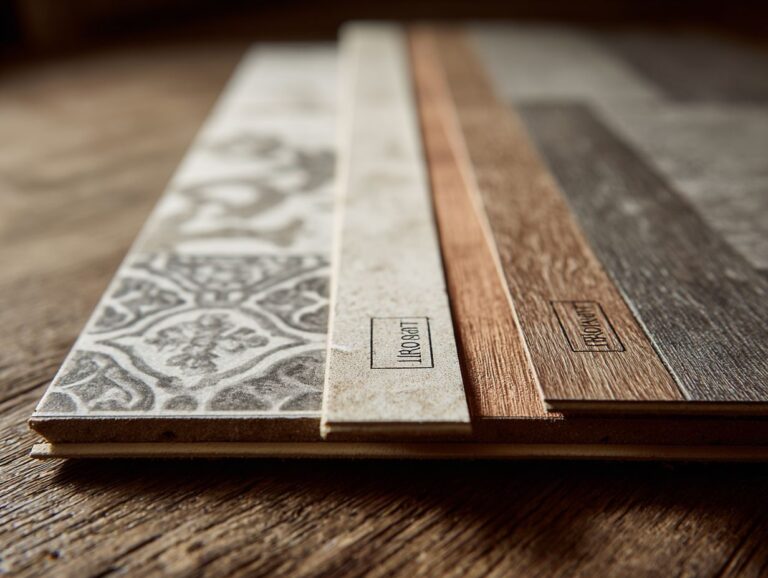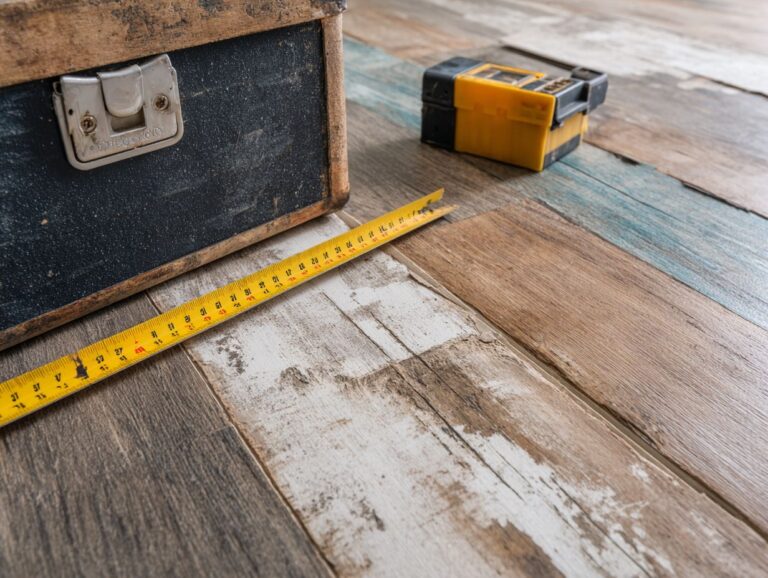Flooring Installation Tools – Complete Equipment Guide
Contents
- Introduction to Flooring Installation Tools
- Essential Flooring Installation Tools
- Flooring Installation Tools Market Data
- Measuring Tools
- Cutting Tools
- Fastening Tools
- Finishing Tools
- Maintenance and Care of Tools
- Frequently Asked Questions
- What are the essential tools needed for flooring installation?
- What is the purpose of a tape measure in flooring installation?
- Why is a chalk line important in flooring installation?
- What is the role of a pry bar in flooring installation?
- Why is a flooring saw or cutter necessary for installation?
- How do I choose the right level for flooring installation?
Introduction to Flooring Installation Tools
Ready to take your flooring project to the next level? Knowing the key tools for installing floors, whether hardwood or vinyl, can greatly impact the outcome. This full equipment guide will show you the essential tools that make the installation process easier, making sure your flooring looks perfect. Learn how the right tools can improve your project and make it easier and quicker to complete!
Key Takeaways:
Importance of Using the Right Tools
Using the right tools makes installation faster and increases accuracy, which directly impacts the quality of the completed flooring.
For example, a carpenter using a miter saw for exact cuts finished the work 30% faster than using a hand saw. Using a laser level ensures accurate leveling, avoiding costly corrections later.
Other tools like a flooring nailer can speed up installation significantly, enhancing both productivity and quality. Using top-notch tools such as the Bosch 4100 table saw makes the job easier and produces smoother edges and joints, giving a polished result.
Overview of Common Flooring Types
Each flooring type, from hardwood to tiles, has unique installation requirements that dictate the tools needed for a successful project.
For cutting hardwood accurately, use a miter saw. A nail gun helps put pieces together quickly, and a tapping block ensures the spacing is right.
In contrast, tile installations require:
- a tile cutter,
- a wet saw for intricate shapes,
- and thin-set mortar for adhesion.
Laminate flooring primarily needs a saw and a mallet for locking mechanisms. Knowing the specific tools needed avoids delays and makes installing smoother, enabling you to plan your budget and collect materials properly before beginning the project. If you’re looking to manage costs effectively, consider exploring our DIY vs Professional Flooring Installation – Cost Analysis for detailed insights.
Essential Flooring Installation Tools
Having the right flooring installation tools is key to getting a professional finish on your flooring project.
Flooring Installation Tools Market Data
Flooring Installation Tools Market Data
Market Growth Projections: Market Value Projections
The Flooring Installation Tools Market Data provides important information about the expected growth of this industry from 2022 to 2027. The data shows important market trends and anticipated performance, offering an overview of the industry’s financial direction and potential for growth.
Market Growth Projections showcase a promising trend with a market size of $124.0 million in 2022 This shows a strong need for tools used in flooring installation, caused by continuous building work and home improvements. The market is forecasted to expand to $155.0 million by 2027, reflecting a healthy growth pattern.
- The anticipated Compound Annual Growth Rate (CAGR) of 4.5% over the five-year period highlights the sector’s consistent growth and strength despite changes in the economy. This growth is likely fueled by innovations in tool design, improving efficiency, and user-friendliness, alongside increasing demand from both residential and commercial sectors.
The data suggests that as the construction industry continues to evolve, the demand for specialized tools will rise, driven by new building technologies, sustainable practices, and the growth of urban areas. Companies in this region plan to benefit from these trends by making wise investments in developing new products and expanding their market reach.
The Flooring Installation Tools Market Data indicates a positive outlook for stakeholders, encouraging investment and innovation. It emphasizes the need to keep up with market needs and new technology to stay competitive and increase market share.
Measuring Tools
Getting the sizes right is important when putting in floors, and reliable measuring tools are necessary to get it right.
To get exact measurements, buy important tools such as a tape measure, a carpenter’s square, and a laser level.
Start by measuring the length and width of the room with the tape measure, ensuring to account for any obstructions.
Next, use the carpenter’s square to make sure your corners are 90 degrees. This is important for making straight cuts.
A laser level will help you check for level surfaces across the room, preventing uneven flooring. Related insight: Flooring Underlayment Installation – Types and Methods can further enhance your flooring projects.
Following these steps can help you avoid expensive errors, saving you both time and money.
Cutting Tools
Tools used for cutting are essential for trimming flooring materials to fit specific areas, ensuring a smooth installation.
Utility knives are effective for making accurate cuts in soft materials like laminate or vinyl.
For thicker, denser products such as hardwood, a circular saw is recommended for straight, clean cuts.
Always prioritize safety by wearing gloves and goggles, especially when using power tools.
Consider using a straight edge as a guide for your cuts, which helps maintain accuracy and reduces mistakes.
Whether you choose a utility knife or a circular saw, ensuring proper technique and safety can make a significant difference in your flooring project.
Fastening Tools
Fastening tools secure flooring materials in place, preventing movement and ensuring durability for the long term.
Among various fastening tools, pneumatic nailers stand out for their efficiency in installing hardwood flooring. These tools effectively drive nails, speeding up the task significantly.
Conversely, glue applicators are ideal for laminate or engineered wood, providing a strong bond without visible fasteners. For optimal performance, when using a pneumatic nailer, adjust the air pressure to match the manufacturer’s guidelines to prevent harm to the wood.
Meanwhile, apply glue evenly with a notched trowel to achieve the most effective adhesion. It’s important to choose the right tool for the type of flooring you have to install it properly.
Finishing Tools
Finishing tools are important in the last steps of flooring installation. They improve the look and help the floor last longer.
Proper use of finishing tools can make a significant difference in the look and durability of your flooring.
- Start with a high-quality sander, such as a drum sander for large areas and an edge sander for corners; these will help remove imperfections.
- Follow with sanding pads at varying grits, beginning with 60 grit and progressing to 120 grit for a smooth finish. Use a floor buffer to enhance shine.
- Apply sealants correctly-polyurethane is popular for hardwood floors-ensuring thorough coverage to protect against wear.
Measuring Tools
Correct measurement is important for a flooring job, so using quality measuring tools is necessary.
Tape Measure
A tape measure is a necessary tool used to accurately measure the size of the installation space.
To get exact measurements, start by firmly attaching one end of the tape measure to the starting point.
When measuring long distances, use a second person to hold the opposite end, preventing any slack that can lead to errors. If you’re alone, consider using a tape measure with a locking feature.
For extremely long measurements, break them into segments, recording each length and summing them afterward. Always make sure the tape is straight and level to avoid inaccuracies, especially when measuring vertical or angled surfaces.
Square and Level
Using a square and level is essential for ensuring that flooring installations are aligned correctly and are uniformly flat.
To begin, place the carpenter’s square in the corners of your installation area to check for a right angle. Make sure both sides of the square touch the walls closely; any space shows that the corner is not square.
Next, use a level on the surface to make sure it’s flat. If your flooring is uneven, consider using a self-leveling compound to address low spots.
Frequently check your measurements as you work to keep each part accurate and avoid problems later.
Laser Level
A laser level can significantly improve the accuracy of your flooring installation by clearly marking the level line over wide areas.
Unlike traditional levels, laser levels project a continuous and straight line, ensuring that your floors are perfectly aligned.
To set up, place the laser on a stable tripod, adjust it to eye level, and power it on.
Troubleshoot common issues by ensuring that batteries are charged and the surface is stable; vibrations can throw off accuracy.
A simple tip: if you’re working in bright conditions, use a green laser to see the lines more clearly.
Cutting Tools
Tools for cutting are necessary for shaping flooring materials to match specific sizes, providing a tight and neat fit when installed.
Utility Knife
A utility knife is a useful tool that works well for precisely cutting vinyl and laminate flooring materials.
Tile Cutter
A tile cutter is specifically designed to make clean cuts on tiles, which is essential for achieving a professional finish.
When choosing a tile cutter, consider whether to use a manual or an electric model. Manual cutters are ideal for small tasks and ceramic tiles. They use a method where you score and then snap the tile, which makes them both inexpensive and easy to carry.
On the other hand, electric cutters are best suited for bigger tasks or tougher materials like porcelain. They provide accuracy and fast operation but are more expensive and need additional preparation.
To cut tiles properly, make sure to measure them carefully, use a ruler to score, and apply even pressure for neat splits.
Flooring Saw
A flooring saw lets you quickly and accurately cut flooring materials, so it’s essential for any dedicated flooring installer.
There are two primary types of saws used in flooring projects: circular saws and jigsaws.
Circular saws, like the DeWalt DWE575SB, are great for cutting straight lines in hardwood flooring because of their strong blades and adjustable cutting depths.
However, jigsaws, like the Bosch JS470E, are great for making detailed cuts and curves, especially in laminate or tile flooring.
To get the best results, choose a saw that suits the material and cut you require for smooth and accurate results.
Fastening Tools
Fastening tools hold flooring materials firmly in place, providing both strength and durability for your flooring.
Nail Gun
Using a nail gun allows you to quickly and easily attach materials, speeding up the installation of hardwood flooring.
Using a nail gun can save hours of labor compared to manual nailing. For example, when installing 1,000 square feet of flooring, it takes approximately 4-6 hours with a nail gun versus 10-12 hours manually.
The pneumatic type makes sure each nail goes in at the same depth, preventing uneven surfaces. Most modern nail guns feature adjustable settings, enabling you to switch between different nail sizes effortlessly, which is particularly useful for varied projects.
Buying a good nail gun can greatly improve both speed and accuracy.
Stapler
A flooring stapler is particularly useful for securing carpet and underlayment, ensuring a tight fit for your flooring.
There are different kinds of flooring staplers you can choose from depending on what your project requires.
- Pneumatic staplers are powerful and efficient, using compressed air for quick fastening.
- Electric staplers provide mobility without the need for an air compressor.
- Manual staplers are affordable and ideal for small jobs, although they require more effort.
When using any stapler, prioritize safety by wearing eye protection and ensuring your hands are clear of the stapling area. Regularly check for jams to maintain performance and avoid mishaps during installation.
Glue Applicator
A glue applicator spreads adhesive evenly on laminate and vinyl flooring, important for a strong bond.
To use a glue applicator effectively, follow these steps:
- Make sure the surface is clean and dry. Dirt or water can make it stick less effectively.
- Next, load the applicator with your chosen adhesive, often polyurethane or water-based glue, compatible with your flooring type.
- While applying, maintain a consistent speed for a uniform coat, avoiding excessive pressure.
Common mistakes include over-applying glue, which can lead to messy finishes, and not allowing adequate curing time, typically 24 hours, which is essential for achieving the strongest bond.
Finishing Tools
Finishing tools improve the look and strength of your flooring, ensuring it looks good and lasts longer.
Trim and Molding Tools
Tools for trim and molding are important for completing the edges of flooring projects to get a neat and smooth finish.
Choosing the right trim and molding tools can significantly affect your flooring finish.
A miter saw is essential for cutting baseboards and crown moldings at certain angles. A coping saw is great for making small, detailed cuts and shapes.
Use a nail gun for quick and secure attachment of trims without damaging the material. A level helps make sure your trim is even and looks good.
Using these tools makes your flooring look better and makes the installation process go more smoothly.
Sanding Tools
Sanding tools are essential for smoothing hardwood floors and preparing them for finishing.
Important sanding tools are:
- Belt sanders for big surfaces
- Orbital sanders for smooth finishes
- Detail sanders for tight corners
When sanding, start with a coarse grit (40-60) to remove old finishes and smooth out rough patches. Follow up with medium grit (80-120) for a smoother surface and finish with fine grit (150-220) to prepare for treatment.
Always sand in the direction of the wood grain to avoid scratches. Collect dust properly to keep your workspace clean and see your work clearly.
Maintenance and Care of Tools
Looking after and regularly maintaining flooring installation tools helps them last longer and work well when you need them.
Cleaning and Storage Tips
Cleaning your tools regularly and storing them correctly can make them last longer and work better for flooring tasks.
To maintain your tools, clean them after each use. For saw blades, use a specialized cleaner to remove pitch and debris; for drills, wipe down with a damp cloth to eliminate dust.
Store tools in a climate-controlled space, avoiding extreme temperatures that can warp handles or rust metal parts. Pegboards or tool chests with padding can prevent damage.
Using tool organizers like the Dewalt Tough System keeps your tools organized, prevents damage, and helps you avoid spending money on replacements.
Frequently Asked Questions
What are the essential tools needed for flooring installation?
The essential tools for flooring installation include a tape measure, chalk line, hammer, utility knife, pry bar, level, and a flooring saw or cutter.
What is the purpose of a tape measure in flooring installation?
A tape measure is used to measure and mark the size of the room and flooring materials, making sure the installation is exact and done professionally.
Why is a chalk line important in flooring installation?
A chalk line helps make straight lines on the subfloor, which simplifies aligning and putting down the flooring materials.
What is the role of a pry bar in flooring installation?
A pry bar is used to remove old flooring materials and to lift and adjust flooring planks during installation.
Why is a flooring saw or cutter necessary for installation?
A flooring saw or cutter is made to cut and trim flooring materials, resulting in tidy and accurate cuts for a smooth finish.
How do I choose the right level for flooring installation?
The most important factor in choosing a level for flooring installation is accuracy. Pick a level that is long enough to cover the width of the room and is very accurate.





